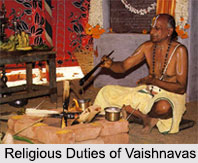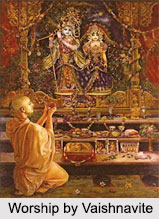 Religious Duties of Vaishnavas are in keeping with their need to dedicate themselves to the worship and service of Lord Vishnu throughout the day right from early morning to the midnight. Ramanuja has observed that they are never to be observed under any circumstances since these are the commands of God. The Vaishnava treatises have codified these religious duties under the title of good deeds to be performed daily.
Religious Duties of Vaishnavas are in keeping with their need to dedicate themselves to the worship and service of Lord Vishnu throughout the day right from early morning to the midnight. Ramanuja has observed that they are never to be observed under any circumstances since these are the commands of God. The Vaishnava treatises have codified these religious duties under the title of good deeds to be performed daily.
Panchakala Prakriya in Vaishnavism
The "Pancharatra Samhitas" have divided the day into five parts and laid down a specific religious routine to be observed by a devoted Vaishnava at each time of the day. This fivefold religious routine is known as "Panchakala Prakriya". This comprises:
1. Abhigamana or Morning Prayer
2. Upaddita or collection of the requisite materials for worship
3. Ijya or formal worship of God
4. Svadhyaya or recitation and study of sacred texts
5. Yoga or contemplation on God
Scriptures on Religious Duties of Vaishnavas
Ramanuja has included the essential features of the five-fold routine in the treatise known as "Nityagrantha" written by him in Sanskrit language. Based on this, one of his immediate successors, Sriranganarayanacarya, also known as Vangivamsesvara has written a work under the title of "Ahnikakarika" giving details of the various religious rituals including the 5 religious duties to be observed by a Vaishnava. Vedanta Desika in his "Pancharatraraksa" has defended the observance of the daily routine as prescribed by the "Pancharatra Samhitas" taking note of all the known criticisms. There are several other treatises of similar kind written by Vaishnava Acharyas.
 Worship of Lord Vishnu in Bhagavata Purana
Worship of Lord Vishnu in Bhagavata Purana
The Bhagavata Purana mentions 9 modes of worship of Lord Vishnu. These are;
1. Sravana or listening to the glory of Vishnu
2. Kirtana or singing the glory of the Lord
3. Smararia or constantly remembering His greatness
4. Padasevana or service to God
5. Archana or offering worship to God`s image
6. Vandana or prostrating before God
7. Dasya or developing the feeling of subordination to Supreme Being
8. Sakhhya or developing a friendly disposition towards God
9. Citmanivedana or surrendering oneself to God
These are easier methods of worshipping God. They do not require any preparatory and purificatory religious ceremonies. There are many other important religious practices which are easy to follow by Vaishnavas even under the compulsions of present-day style of living.
Significance of Kirtana in Vaishnavism
Of all these, Kirtana or singing the names of God is the easiest which can be followed even by laymen. The same is known as "Bhajana" in popular language and is performed everywhere by groups of devout Vaishnavas. The recent Vaishnava movement of the Krishna Consciousness in the West which has adopted among others the bhajana as a form of mass worship is a case in point. When Vaishnavism of Ramanuja spread in other parts of India, bhajana became a popular method of adoration of Vishnu by the masses. Even today, it is the most popular form of participation by the masses all over India.




















